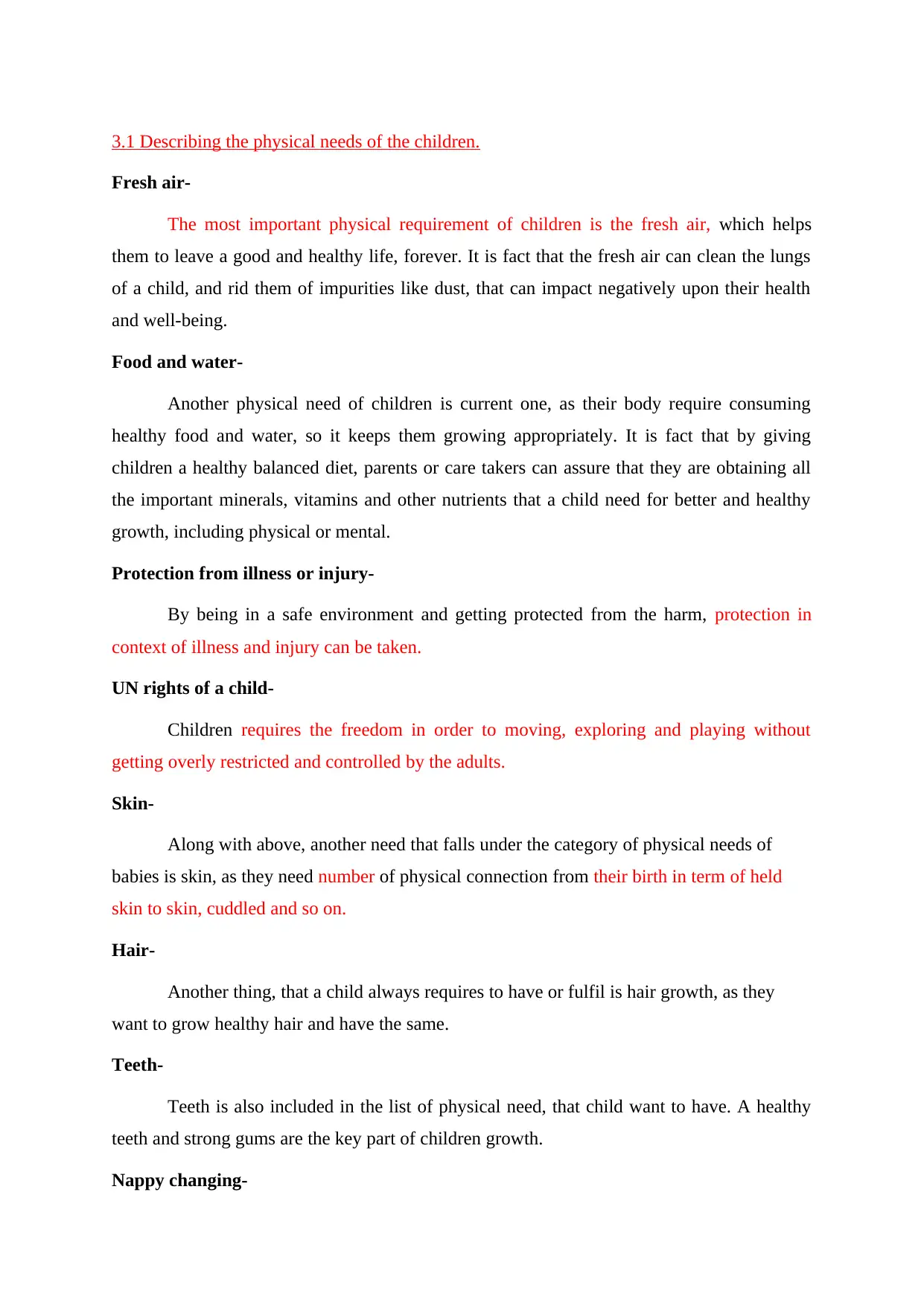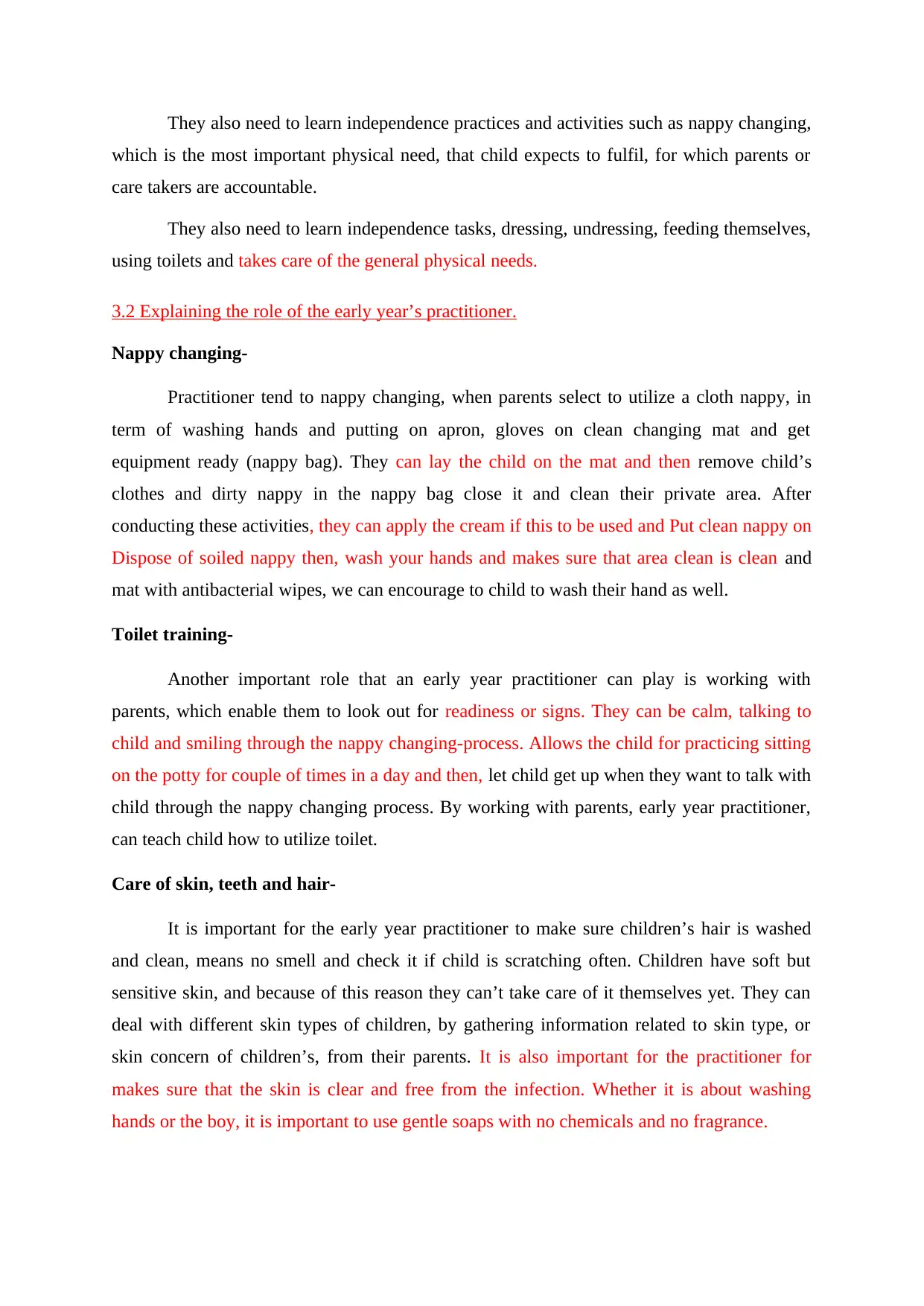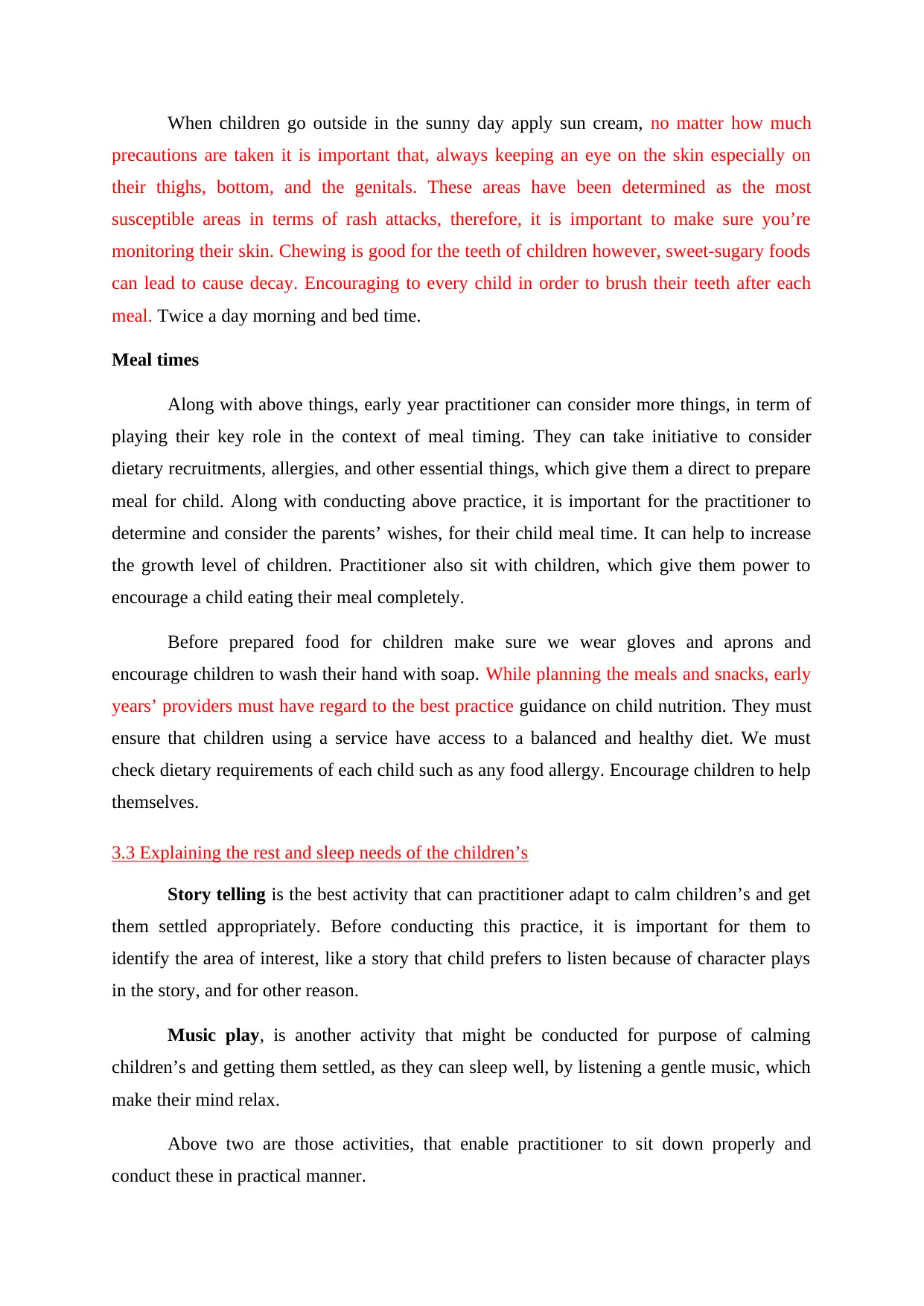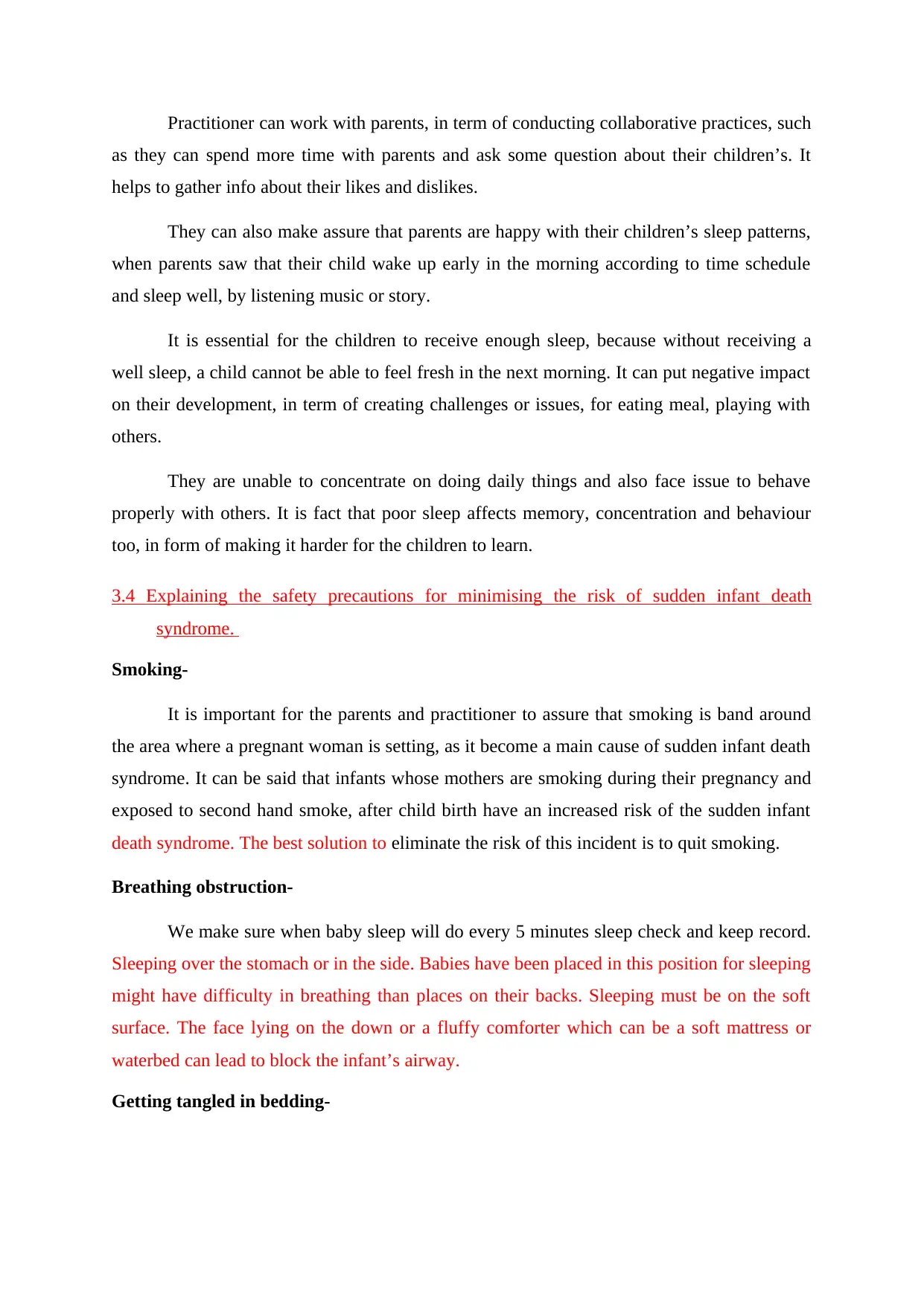Analyzing Child Development: Physical Needs & Practitioner's Role
VerifiedAdded on 2023/06/04
|6
|1656
|357
Report
AI Summary
This report comprehensively addresses the physical needs of children, emphasizing the importance of fresh air, balanced nutrition, and protection from illness and injury. It details the critical role of early years practitioners in nappy changing, toilet training, skin, teeth, and hair care, and ensuring proper meal times. The report also explores rest and sleep needs, highlighting the use of storytelling and music to calm children, and the importance of collaboration with parents. Furthermore, it outlines safety precautions to minimize the risk of Sudden Infant Death Syndrome (SIDS), including avoiding smoking, ensuring proper sleeping positions, and addressing minor illnesses promptly. Desklib offers this solved assignment and many other resources for students.

3.1 Describing the physical needs of the children.
Fresh air-
The most important physical requirement of children is the fresh air, which helps
them to leave a good and healthy life, forever. It is fact that the fresh air can clean the lungs
of a child, and rid them of impurities like dust, that can impact negatively upon their health
and well-being.
Food and water-
Another physical need of children is current one, as their body require consuming
healthy food and water, so it keeps them growing appropriately. It is fact that by giving
children a healthy balanced diet, parents or care takers can assure that they are obtaining all
the important minerals, vitamins and other nutrients that a child need for better and healthy
growth, including physical or mental.
Protection from illness or injury-
By being in a safe environment and getting protected from the harm, protection in
context of illness and injury can be taken.
UN rights of a child-
Children requires the freedom in order to moving, exploring and playing without
getting overly restricted and controlled by the adults.
Skin-
Along with above, another need that falls under the category of physical needs of
babies is skin, as they need number of physical connection from their birth in term of held
skin to skin, cuddled and so on.
Hair-
Another thing, that a child always requires to have or fulfil is hair growth, as they
want to grow healthy hair and have the same.
Teeth-
Teeth is also included in the list of physical need, that child want to have. A healthy
teeth and strong gums are the key part of children growth.
Nappy changing-
Fresh air-
The most important physical requirement of children is the fresh air, which helps
them to leave a good and healthy life, forever. It is fact that the fresh air can clean the lungs
of a child, and rid them of impurities like dust, that can impact negatively upon their health
and well-being.
Food and water-
Another physical need of children is current one, as their body require consuming
healthy food and water, so it keeps them growing appropriately. It is fact that by giving
children a healthy balanced diet, parents or care takers can assure that they are obtaining all
the important minerals, vitamins and other nutrients that a child need for better and healthy
growth, including physical or mental.
Protection from illness or injury-
By being in a safe environment and getting protected from the harm, protection in
context of illness and injury can be taken.
UN rights of a child-
Children requires the freedom in order to moving, exploring and playing without
getting overly restricted and controlled by the adults.
Skin-
Along with above, another need that falls under the category of physical needs of
babies is skin, as they need number of physical connection from their birth in term of held
skin to skin, cuddled and so on.
Hair-
Another thing, that a child always requires to have or fulfil is hair growth, as they
want to grow healthy hair and have the same.
Teeth-
Teeth is also included in the list of physical need, that child want to have. A healthy
teeth and strong gums are the key part of children growth.
Nappy changing-
Paraphrase This Document
Need a fresh take? Get an instant paraphrase of this document with our AI Paraphraser

They also need to learn independence practices and activities such as nappy changing,
which is the most important physical need, that child expects to fulfil, for which parents or
care takers are accountable.
They also need to learn independence tasks, dressing, undressing, feeding themselves,
using toilets and takes care of the general physical needs.
3.2 Explaining the role of the early year’s practitioner.
Nappy changing-
Practitioner tend to nappy changing, when parents select to utilize a cloth nappy, in
term of washing hands and putting on apron, gloves on clean changing mat and get
equipment ready (nappy bag). They can lay the child on the mat and then remove child’s
clothes and dirty nappy in the nappy bag close it and clean their private area. After
conducting these activities, they can apply the cream if this to be used and Put clean nappy on
Dispose of soiled nappy then, wash your hands and makes sure that area clean is clean and
mat with antibacterial wipes, we can encourage to child to wash their hand as well.
Toilet training-
Another important role that an early year practitioner can play is working with
parents, which enable them to look out for readiness or signs. They can be calm, talking to
child and smiling through the nappy changing-process. Allows the child for practicing sitting
on the potty for couple of times in a day and then, let child get up when they want to talk with
child through the nappy changing process. By working with parents, early year practitioner,
can teach child how to utilize toilet.
Care of skin, teeth and hair-
It is important for the early year practitioner to make sure children’s hair is washed
and clean, means no smell and check it if child is scratching often. Children have soft but
sensitive skin, and because of this reason they can’t take care of it themselves yet. They can
deal with different skin types of children, by gathering information related to skin type, or
skin concern of children’s, from their parents. It is also important for the practitioner for
makes sure that the skin is clear and free from the infection. Whether it is about washing
hands or the boy, it is important to use gentle soaps with no chemicals and no fragrance.
which is the most important physical need, that child expects to fulfil, for which parents or
care takers are accountable.
They also need to learn independence tasks, dressing, undressing, feeding themselves,
using toilets and takes care of the general physical needs.
3.2 Explaining the role of the early year’s practitioner.
Nappy changing-
Practitioner tend to nappy changing, when parents select to utilize a cloth nappy, in
term of washing hands and putting on apron, gloves on clean changing mat and get
equipment ready (nappy bag). They can lay the child on the mat and then remove child’s
clothes and dirty nappy in the nappy bag close it and clean their private area. After
conducting these activities, they can apply the cream if this to be used and Put clean nappy on
Dispose of soiled nappy then, wash your hands and makes sure that area clean is clean and
mat with antibacterial wipes, we can encourage to child to wash their hand as well.
Toilet training-
Another important role that an early year practitioner can play is working with
parents, which enable them to look out for readiness or signs. They can be calm, talking to
child and smiling through the nappy changing-process. Allows the child for practicing sitting
on the potty for couple of times in a day and then, let child get up when they want to talk with
child through the nappy changing process. By working with parents, early year practitioner,
can teach child how to utilize toilet.
Care of skin, teeth and hair-
It is important for the early year practitioner to make sure children’s hair is washed
and clean, means no smell and check it if child is scratching often. Children have soft but
sensitive skin, and because of this reason they can’t take care of it themselves yet. They can
deal with different skin types of children, by gathering information related to skin type, or
skin concern of children’s, from their parents. It is also important for the practitioner for
makes sure that the skin is clear and free from the infection. Whether it is about washing
hands or the boy, it is important to use gentle soaps with no chemicals and no fragrance.

When children go outside in the sunny day apply sun cream, no matter how much
precautions are taken it is important that, always keeping an eye on the skin especially on
their thighs, bottom, and the genitals. These areas have been determined as the most
susceptible areas in terms of rash attacks, therefore, it is important to make sure you’re
monitoring their skin. Chewing is good for the teeth of children however, sweet-sugary foods
can lead to cause decay. Encouraging to every child in order to brush their teeth after each
meal. Twice a day morning and bed time.
Meal times
Along with above things, early year practitioner can consider more things, in term of
playing their key role in the context of meal timing. They can take initiative to consider
dietary recruitments, allergies, and other essential things, which give them a direct to prepare
meal for child. Along with conducting above practice, it is important for the practitioner to
determine and consider the parents’ wishes, for their child meal time. It can help to increase
the growth level of children. Practitioner also sit with children, which give them power to
encourage a child eating their meal completely.
Before prepared food for children make sure we wear gloves and aprons and
encourage children to wash their hand with soap. While planning the meals and snacks, early
years’ providers must have regard to the best practice guidance on child nutrition. They must
ensure that children using a service have access to a balanced and healthy diet. We must
check dietary requirements of each child such as any food allergy. Encourage children to help
themselves.
3.3 Explaining the rest and sleep needs of the children’s
Story telling is the best activity that can practitioner adapt to calm children’s and get
them settled appropriately. Before conducting this practice, it is important for them to
identify the area of interest, like a story that child prefers to listen because of character plays
in the story, and for other reason.
Music play, is another activity that might be conducted for purpose of calming
children’s and getting them settled, as they can sleep well, by listening a gentle music, which
make their mind relax.
Above two are those activities, that enable practitioner to sit down properly and
conduct these in practical manner.
precautions are taken it is important that, always keeping an eye on the skin especially on
their thighs, bottom, and the genitals. These areas have been determined as the most
susceptible areas in terms of rash attacks, therefore, it is important to make sure you’re
monitoring their skin. Chewing is good for the teeth of children however, sweet-sugary foods
can lead to cause decay. Encouraging to every child in order to brush their teeth after each
meal. Twice a day morning and bed time.
Meal times
Along with above things, early year practitioner can consider more things, in term of
playing their key role in the context of meal timing. They can take initiative to consider
dietary recruitments, allergies, and other essential things, which give them a direct to prepare
meal for child. Along with conducting above practice, it is important for the practitioner to
determine and consider the parents’ wishes, for their child meal time. It can help to increase
the growth level of children. Practitioner also sit with children, which give them power to
encourage a child eating their meal completely.
Before prepared food for children make sure we wear gloves and aprons and
encourage children to wash their hand with soap. While planning the meals and snacks, early
years’ providers must have regard to the best practice guidance on child nutrition. They must
ensure that children using a service have access to a balanced and healthy diet. We must
check dietary requirements of each child such as any food allergy. Encourage children to help
themselves.
3.3 Explaining the rest and sleep needs of the children’s
Story telling is the best activity that can practitioner adapt to calm children’s and get
them settled appropriately. Before conducting this practice, it is important for them to
identify the area of interest, like a story that child prefers to listen because of character plays
in the story, and for other reason.
Music play, is another activity that might be conducted for purpose of calming
children’s and getting them settled, as they can sleep well, by listening a gentle music, which
make their mind relax.
Above two are those activities, that enable practitioner to sit down properly and
conduct these in practical manner.
⊘ This is a preview!⊘
Do you want full access?
Subscribe today to unlock all pages.

Trusted by 1+ million students worldwide

Practitioner can work with parents, in term of conducting collaborative practices, such
as they can spend more time with parents and ask some question about their children’s. It
helps to gather info about their likes and dislikes.
They can also make assure that parents are happy with their children’s sleep patterns,
when parents saw that their child wake up early in the morning according to time schedule
and sleep well, by listening music or story.
It is essential for the children to receive enough sleep, because without receiving a
well sleep, a child cannot be able to feel fresh in the next morning. It can put negative impact
on their development, in term of creating challenges or issues, for eating meal, playing with
others.
They are unable to concentrate on doing daily things and also face issue to behave
properly with others. It is fact that poor sleep affects memory, concentration and behaviour
too, in form of making it harder for the children to learn.
3.4 Explaining the safety precautions for minimising the risk of sudden infant death
syndrome.
Smoking-
It is important for the parents and practitioner to assure that smoking is band around
the area where a pregnant woman is setting, as it become a main cause of sudden infant death
syndrome. It can be said that infants whose mothers are smoking during their pregnancy and
exposed to second hand smoke, after child birth have an increased risk of the sudden infant
death syndrome. The best solution to eliminate the risk of this incident is to quit smoking.
Breathing obstruction-
We make sure when baby sleep will do every 5 minutes sleep check and keep record.
Sleeping over the stomach or in the side. Babies have been placed in this position for sleeping
might have difficulty in breathing than places on their backs. Sleeping must be on the soft
surface. The face lying on the down or a fluffy comforter which can be a soft mattress or
waterbed can lead to block the infant’s airway.
Getting tangled in bedding-
as they can spend more time with parents and ask some question about their children’s. It
helps to gather info about their likes and dislikes.
They can also make assure that parents are happy with their children’s sleep patterns,
when parents saw that their child wake up early in the morning according to time schedule
and sleep well, by listening music or story.
It is essential for the children to receive enough sleep, because without receiving a
well sleep, a child cannot be able to feel fresh in the next morning. It can put negative impact
on their development, in term of creating challenges or issues, for eating meal, playing with
others.
They are unable to concentrate on doing daily things and also face issue to behave
properly with others. It is fact that poor sleep affects memory, concentration and behaviour
too, in form of making it harder for the children to learn.
3.4 Explaining the safety precautions for minimising the risk of sudden infant death
syndrome.
Smoking-
It is important for the parents and practitioner to assure that smoking is band around
the area where a pregnant woman is setting, as it become a main cause of sudden infant death
syndrome. It can be said that infants whose mothers are smoking during their pregnancy and
exposed to second hand smoke, after child birth have an increased risk of the sudden infant
death syndrome. The best solution to eliminate the risk of this incident is to quit smoking.
Breathing obstruction-
We make sure when baby sleep will do every 5 minutes sleep check and keep record.
Sleeping over the stomach or in the side. Babies have been placed in this position for sleeping
might have difficulty in breathing than places on their backs. Sleeping must be on the soft
surface. The face lying on the down or a fluffy comforter which can be a soft mattress or
waterbed can lead to block the infant’s airway.
Getting tangled in bedding-
Paraphrase This Document
Need a fresh take? Get an instant paraphrase of this document with our AI Paraphraser

Another cause of sudden infant death syndrome is getting tangled in bedding, which is
important for the parents to take care appropriately. They can take initiative to keep their
sleeping baby close, until they cannot handle themselves, during sleep time.
A minor illness-
A minor illness such as cold, can also become a major cause of sudden infant death
syndrome. Parents can take precaution to eliminate the reason behind SIDS is to reach a child
health care specialist, who can provide a good treatment, to heal child and cure illness.
important for the parents to take care appropriately. They can take initiative to keep their
sleeping baby close, until they cannot handle themselves, during sleep time.
A minor illness-
A minor illness such as cold, can also become a major cause of sudden infant death
syndrome. Parents can take precaution to eliminate the reason behind SIDS is to reach a child
health care specialist, who can provide a good treatment, to heal child and cure illness.

References:
3.2 old field years learning centre
3.3 neastbean.com
3.4 Nhs.com
3.2 old field years learning centre
3.3 neastbean.com
3.4 Nhs.com
⊘ This is a preview!⊘
Do you want full access?
Subscribe today to unlock all pages.

Trusted by 1+ million students worldwide
1 out of 6
Related Documents
Your All-in-One AI-Powered Toolkit for Academic Success.
+13062052269
info@desklib.com
Available 24*7 on WhatsApp / Email
![[object Object]](/_next/static/media/star-bottom.7253800d.svg)
Unlock your academic potential
Copyright © 2020–2025 A2Z Services. All Rights Reserved. Developed and managed by ZUCOL.




